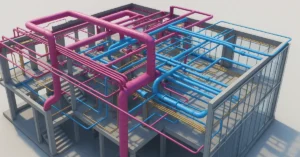Explore the striking brutalist buildings in Cairo
Brutalist buildings in Cairo offer a compelling narrative of a city balancing tradition with modernist ambitions. These concrete giants, often misunderstood and underrated, form a distinct part of Cairo’s architectural heritage. Characterized by raw concrete textures, massive geometric forms, and a utilitarian ethos, Brutalism in Cairo is both a physical and symbolic testament to mid-20th-century aspirations.
This blog explores the evolution, key examples, cultural context, and preservation challenges of Brutalist architecture in Egypt’s bustling capital. Whether you’re an architecture enthusiast, history buff, or a curious traveler, Cairo’s brutalist landmarks provide a unique window into a transformative period.
Understanding Brutalism in Cairo’s Architectural Landscape
Brutalism emerged worldwide as a reaction to ornate styles and a need for functional, economical architecture after World War II. In Cairo, it arrived during a time of rapid urban expansion, social change, and political modernization. The city’s brutalist structures blend local cultural motifs with the global brutalist language of exposed concrete and blocky forms.
Egypt’s post-colonial governments sought to project strength, progress, and national identity through monumental buildings. Brutalism’s rugged honesty and monumental scale matched these ambitions, creating spaces that were both practical and symbolic. This approach suited Cairo’s needs for schools, government buildings, cultural centers, and housing during the mid-20th century.
Top Brutalist Buildings in Cairo
1. The Cairo Tower (Gezira Island)
Year Completed: 1961
Although not purely brutalist, the Cairo Tower’s reinforced concrete structure and sculptural form align with brutalist principles. Standing tall on Gezira Island, it symbolizes modernity and national pride. The lattice pattern concrete exterior is a bold statement of structural artistry and engineering innovation.
2. The Arab League Headquarters
Location: Tahrir Square
Year Completed: 1956
This building combines monumental massing with textured concrete facades, reflecting the post-colonial pan-Arab aspirations. Its imposing Brutalist presence asserts political strength and unity.
3. The National Theatre of Egypt
Location: Zamalek
Year: 1960s
The theatre’s heavy use of raw concrete, sharp angles, and massive block volumes perfectly capture Brutalist ideals. It was designed to be functional yet imposing, serving as a cultural hub in Cairo’s arts scene.
4. The Ministry of Foreign Affairs Building
Location: Downtown Cairo
Year: 1970s
This governmental building showcases Brutalism’s typical exposed concrete and repetitive modular forms. It projects authority and stability through its fortress-like appearance, embodying state power during a time of geopolitical change.
5. The Faculty of Engineering, Cairo University
Location: Giza
Year: 1960s
The faculty building combines Brutalist form with educational function. Its large, angular concrete volumes create dynamic interior spaces while embodying a modern, institutional aesthetic.
6. Residential Complexes in Nasr City
Nasr City’s large-scale housing projects display the utilitarian aspect of Brutalism. Designed to accommodate the rapidly growing urban population, these buildings focus on affordability and durability through raw concrete and repetitive modular units.
7. The Social Insurance Building
Location: Downtown Cairo
Year: 1970s
Another classic example, this building’s rigid concrete grid and minimalist design symbolize bureaucratic efficiency and social modernism.
Why Brutalism Resonated in Cairo
Cairo’s Brutalist architecture reflects the city’s complex socio-political evolution in the 20th century. The style’s affordability, speed of construction, and monumental scale matched Egypt’s ambitions to modernize while asserting independence from colonial legacies.
The Egyptian government embraced Brutalism to build civic pride and national identity through public buildings that were functional and awe-inspiring. The aesthetic also reflected global architectural trends, linking Cairo with a broader narrative of post-war modernism.
Cultural and Public Perception of Brutalism in Cairo
Like many cities, Cairo’s brutalist buildings receive mixed public reactions. To some, their stark concrete exteriors and heavy masses feel cold or oppressive. However, architects and preservationists argue these structures are vital cultural artifacts embodying a crucial historical moment.
Recently, interest has grown among younger Egyptians and design professionals in preserving and reinterpreting Brutalist architecture. Social media platforms and urban exploration tours are bringing attention to these overlooked landmarks.
Preservation Challenges
Many Brutalist buildings in Cairo face threats from neglect, environmental damage, and urban redevelopment pressures. Concrete deterioration, pollution, and lack of maintenance have accelerated decay. Additionally, changing tastes favor glass-and-steel modern towers, leading to demolition risks.
Preserving Cairo’s brutalist heritage requires advocacy, public education, and adaptive reuse strategies. Successfully integrating these buildings into the city’s future urban fabric could preserve their historical and architectural value.
Brutalist Architecture’s Lasting Legacy in Cairo
Brutalist buildings in Cairo stand as powerful symbols of a transformative era. Beyond their raw aesthetics, they tell stories of ambition, resilience, and cultural identity. These concrete giants remind us that architecture is never just about form but about society, politics, and history.
Their presence challenges us to rethink urban progress and preservation. Embracing Brutalist architecture in Cairo means valuing honesty in design, monumentality, and the layered narratives of a city continuously evolving.
Conclusion
Brutalist buildings in Cairo represent more than just architectural style; they are monumental testaments to Egypt’s modern history and cultural identity. While often misunderstood, these structures embody boldness and resilience through their imposing concrete forms.
Protecting and appreciating Cairo’s brutalist heritage offers a chance to honor the city’s past while inspiring future architectural innovation. Next time you wander Cairo’s streets, look closely—you might discover a brutalist masterpiece that tells the story of a nation’s journey through concrete and ambition.
If you’re interested in learning more about architecture firms in Europe, check out this comprehensive list of the top 50 firms compiled by Archgyan. From innovative startups to long-established industry leaders, this list has it all. Take a look and discover some of the most inspiring and influential architecture firms in Europe today.
If you’re interested in architecture and want to learn more about this amazing field, subscribe to our podcast on youtube
For more SketchUp tutorials, head to https://www.sketchupguru.com










